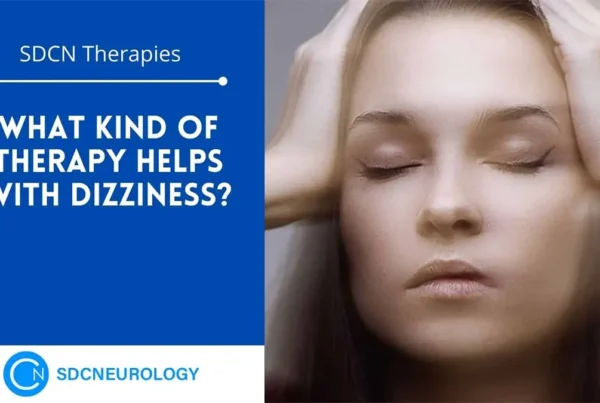
You stand up too fast and suddenly the world around you is spinning and you feel completely off-balance. It isn’t a fun feeling! Don’t fear, it is a common occurrence for many people and usually doesn’t indicate a serious condition. Most commonly people with vertigo have “BPPV” or Benign Paroxysmal Positional Vertigo, but many other vestibular conditions can cause vertigo. Some people may experience vertigo only once while others may have repeated occurrences during their lifetime. For some people, it can be very mild while others may have severe symptoms. While sometimes BPPV can affect both ears, it usually only affects one ear.
What is Vertigo?
Commonly referred to as simply “vertigo,” benign paroxysmal positional vertigo is a disorder of the inner ear that creates a sensation that the room is spinning. In addition to the initial spinning sensation, other symptoms can include lightheadedness, nausea, and vomiting. Simple movements like rolling over or sitting up, looking down, and other similar movements can cause a vertigo episode. Vertigo itself isn’t life-threatening and most cases are caused by BPPV. However, being vigilant with your health is always important and recurring spells or other changes such as vision loss, numbness, confusion, or slurred speech, could signal something else is wrong and you should see a doctor immediately.
What Causes Vertigo?
While there can be other causes of vertigo, BPPV is the most common. BPPV happens when calcium carbonate crystals become trapped in tiny canals within the inner ear. The crystals are naturally occurring and normally dissolve. However, the calcium carbonate crystals can become displaced, affecting the part of the inner ear that controls balance by stimulating the cilia that communicate with the brain about balance. The brain becomes confused by the mixed-up signals. Other causes of vertigo can be inner ear infections, severe migraines, inflammation and medications. Older adults are especially prone to experiencing vertigo including BPPV.
How Do You Treat Vertigo?
Sometimes vertigo will actually resolve on its own when the crystals work themselves out of the canal, but when it doesn’t there are a few treatment options. The most common treatments are the Epley Maneuver and the Semont Maneuver. Other treatments include the Half-Somersault or Foster Maneuver or the Brandt-Daroff Exercise. You can learn more about these exercises in our “Home Remedies for BPPV” post here. Sometimes BPPV can be caused by an injury to your neck or muscles.
Depending on what you have going on you may receive vestibular therapy, vision therapy, and manual therapy for your condition. Seeing a specialist trained in vestibular conditions is important so that you can figure out what is causing your vertigo and what therapies you will need since it varies based on your condition.
How to Tell Which Ear is Causing Your Vertigo?
It can be difficult to tell which ear is actually causing your vertigo when the world feels as though it is spinning! But, to treat vertigo, you do need to know which ear is the culprit.
- Lie down on the bed with your head slightly hanging over the side or end.
- Turn your head to the right and wait for 60 seconds.
- Are you dizzy or experiencing symptoms? Then your right ear might be causing your vertigo.
- If you don’t feel dizzy, sit up and wait at least 1 minute.
- Lie down again with your head slightly hanging over the side or end.
- Turn your head to the left and wait for 60 seconds.
- Are you experiencing symptoms? Then your left ear may be causing causing vertigo.
Once you’ve determined which ear is affecting your balance and causing your bout with vertigo, the next step is treatment. As always, you should consult your doctor prior to trying any at-home remedies. The doctor can show you how to do the maneuvers and exercises correctly. There are several at-home treatment options and if those don’t work, be sure to consult your doctor again. You may be doing the at-home treatments incorrectly or another treatment plan might be needed. If the type of dizziness doesn’t match up with what was described as well, talking to a vestibular specialist can help identify what is the root cause of your dizziness.
The doctors at SDCN are highly trained in identifying vestibular dysfunction and correcting it with functional neurology therapies. Call our office to learn more about our approach at (619)-344-0111.
If you or someone you know is looking for help or has questions about the above condition please click on the button below to set up a consultation with one of our doctors.
Disclaimer: This content (the blog, video, description, links, and comments) is not medical advice or a treatment plan and is intended for general education and demonstration purposes only. This content should not be used to self-diagnose or self-treat any health, medical, or physical condition. Don’t use this content to avoid going to your own healthcare professional or to replace the advice they give you. Consult with your healthcare professional before doing anything contained in this content. You agree to indemnify and hold harmless San Diego Chiropractic Neurology by Albinder and Jahangiri, APC, its officers, employees, and contractors for any and all losses, injuries, or damages resulting from any and all claims that arise from your use or misuse of this content. San Diego Chiropractic Neurology by Albinder and Jahangiri, APC makes no representations about the accuracy or suitability of this content. Use of this content is at your sole risk.





